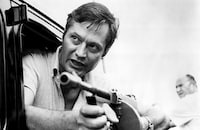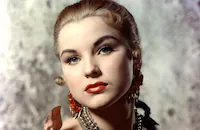The Haunted Palace

Brief Synopsis
Cast & Crew
Roger Corman
Vincent Price
Debra Paget
Lon Chaney [jr.]
Frank Maxwell
Leo Gordon
Film Details
Technical Specs

Synopsis
In 1765, several persons disappear from the New England village of Arkham. The townspeople soon discover that Squire Joseph Curwen is a warlock who with the aid of Hester Tillinghast is sacrificing village girls. Curwen is set upon by the villagers and burned alive. Through the flames, Curwen vows revenge upon the villagers and their descendants. A century later, Curwen's great-great-grandson, Charles Dexter Ward, and his wife, Ann, reopen the Curwen mansion. The villagers, who fear Curwen's curse, are openly hostile to Ward. Ward discovers mutants living near the village who, according to Dr. Marinus Willet, the only villager to befriend the Wards, are direct descendants of the villagers who burned Curwen. Ward comes under the spell of a portrait of his ancestor, whom he resembles, and is befriended by Simon Orne and Jabez Hutchinson, themselves warlocks. Together they resurrect Hester, and Curwen (in Ward's body) prepares to sacrifice Ann. Meanwhile, the villagers storm the house and burn the portrait. Ward is released from the spell, but once they are safely away from the burning mansion, the couple's features appear to undergo a change: Ward becomes Curwen and Ann becomes Hester.

Director

Roger Corman
Cast

Vincent Price

Debra Paget

Lon Chaney [jr.]
Frank Maxwell
Leo Gordon

Elisha Cook
John Dierkes
Milton Parsons
Cathy Merchant
Guy Wilkerson
Harry Ellerbe
I. Stanford Jolley
Darlene Lucht
Barboura Morris
Bruno Ve Sota
Crew
Armand Acosta
Samuel Z. Arkoff
Charles Beaumont
Jack Bohrer
Jack Bohrer
John Bury
Ted Coodley
Roger Corman
Marjorie Corso
Betty Crosby
Floyd Crosby
Daniel Haller
Charles Hannawalt
Dennis Jacob
James H. Nicholson
Paul Rapp
Harry Reif
Lorraine Roberson
Dick Rubin
Ronald Sinclair
Ronald Sinclair
Ronald Stein
Harry Sundby
Harry Underwood

Photo Collections
Videos
Movie Clip



Trailer
Film Details
Technical Specs

Articles
The Haunted Palace (1963)
The original story The Case of Charles Dexter Ward was not published during H. P. Lovecraft's lifetime. After the author's death in 1937, his friends and fellow pulp writers August Derleth and Donald Wandrei went through his papers and voluminous unpublished work. The short novel was first published in an abridged form as a two-part story in the May and July 1941 issues of Weird Tales magazine, and the unedited novella appeared in the second collection of Lovecraft published by Arkham House in 1943, Beyond the Wall of Sleep.
Corman hired Charles Beaumont to handle the scripting chores, and Beaumont remained fairly faithful to Lovecraft's story. In the New England village of Arkham in 1765, madman Joseph Curwen (Vincent Price) is confronted by the townsfolk for bringing young women to his castle for mysterious experiments. Curwen is burned alive at the stake, and spits out a curse upon the villagers. A hundred years later, family heir Charles Dexter Ward (also Price) arrives with his wife Ann (Debra Paget) to claim an inheritance of the castle. The village people are immediately unfriendly to them; they believe that his great-great-grandfather's curse has caused a series of mutant births in generations of townsfolk. Ward and his wife are welcomed to the castle by the caretaker, Simon Orne (Lon Chaney, Jr.), and Ward eventually has a confidante in Dr. Willet (Frank Maxwell), who tells Ward more about Curwen. The warlock and his associates (including Simon) dealt in the Black Arts, and sought to use the book of Necronomicon to summon the Old Ones - the alien Elder Gods - and create a new species on Earth with the young women of the village. Ward finds himself uncomfortably familiar with the layout and purpose of the castle, and increasingly under the spell of a powerful portrait of Curwen hanging in the house.
In an interview accompanying the DVD release of The Haunted Palace, Roger Corman talks about another contribution made to the film: "After Chuck wrote the script, and it was a good script, he went on to work for [The] Twilight Zone, and I wanted a few more changes, so my ace assistant, Francis Ford Coppola, came in and as with all my assistants, he was expected to do everything. [He did a] dialogue polish on the picture - he was there helping the actors go over the lines and prepare for the shooting." On the design of the movie, Corman said "I envisioned, and I think I got, a slightly different look for Lovecraft than I used for Poe... I used a somewhat starker lighting pattern, because I felt that that was intrinsically the difference between Lovecraft and Poe, and we should have a slightly more realistic, starker look - more straightforward than Poe."
Vincent Price gives a bravura performance in The Haunted Palace in the dual role, although the well-shaded takeover of the gentlemanly Charles Dexter Ward by his evil ancestor is somewhat undercut by too much ghoulishly-tinted facial greasepaint. Price was interviewed in 1987 by David Del Valle, and he spoke well of The Haunted Palace, saying, "It wasn't bad. It was a good idea and a good film. I don't know why they just couldn't have left the Lovecraft title to it." For fans of classic horror, The Haunted Palace offers a unique pairing of two of the great horror film icons - Price and Lon Chaney, Jr. Price later said that "Lon Chaney was very ill at that time. I had admired him and always wanted to meet him. He was not very happy or very well, and I really didn't get to know him well. I spent a lot of time trying to talk to him and make him cheer up, but I couldn't do it. He was sick."
AIP not only used Poe's name in the advertising for The Haunted Palace; they also had a tagline that alluded to an earlier Poe/ Price hit: "What was the terrifying thing in the PIT that wanted women?" It was rather short-sighted of AIP; instead of touting Poe, they could have opened up a new avenue of exploitation by emphasizing Lovecraft and his entirely new (to films) world of Elder Gods, Necromancy, and creatures from other dimensions. The pressbook for the film makes no mention of Lovecraft - rather they encourage the exhibitor to emphasize Poe but they stress that "For the first time, [AIP] adds an entirely new element of suspense to the famed writer's chills, foreboding atmosphere and eerie settings. The new element is that of the weird occult science of necromancy (black magic) and its practitioners... It is this black magic, its exercise by warlocks and how an entire village is affected by one of the most horrible curses ever depicted in motion pictures which is the basis of the story 'The Haunted Palace.'" True enough - it's just a shame that the source of the new element wasn't properly credited in the publicity.
The art designer of The Haunted Palace, Daniel Haller, went on to direct two Lovecraft adaptations of his own, Die, Monster, Die! (1965) and The Dunwich Horror (1970). Lovecraft's novella The Case of Charles Dexter Ward was later adapted by director Dan O'Bannon as The Resurrected (1992), in which Chris Sarandon took the Ward/ Joseph Curwen dual role.
Producer: Roger Corman
Director: Roger Corman
Screenplay: Charles Beaumont; H.P. Lovecraft (story "The Case of Charles Dexter Ward"); Francis Ford Coppola (additional dialogue uncredited)
Cinematography: Floyd Crosby
Art Direction: Daniel Haller
Music: Ronald Stein
Film Editing: Ronald Sinclair
Cast: Vincent Price (Charles Dexter Ward/Joseph Curwen), Debra Paget (Ann Ward), Lon Chaney (Simon Orne), Frank Maxwell (Dr. Willet/Priam Willet), Leo Gordon (Edgar Weeden/Ezra Weeden), Elisha Cook (Gideon Smith/Micah Smith), John Dierkes (Benjamin West/Mr. West), Milton Parsons (Jabez Hutchinson), Cathie Merchant (Hester Tillinghast), Guy Wilkerson (Gideon Leach/Mr. Leach), Stanford Jolley (Carmody, coachman), Harry Ellerbe (minister), Barboura Morris (Mrs. Weeden), Darlene Lucht (Miss Fitch), Bruno Ve Sota (Bruno, the bartender)
C-87m.
by John M. Miller

The Haunted Palace (1963)
Quotes
Trivia
Roger Corman decided to do an H.P. Lovecraft story as a break from his 'Edgar Allen Poe' series while keeping the elements that made the "Poe" series successful. American International took no chances. They gave the film a "Poe" title and marketed it as another in Corman's "Poe" series.
Miscellaneous Notes
Released in United States 1963
Released in United States on Video July 3, 1991
A warlock, burned at the stake, vows vengeance on the townspeople who killed him, and returns in the embodiment of his great-great grandson.
Released in United States 1963
Released in United States on Video July 3, 1991














